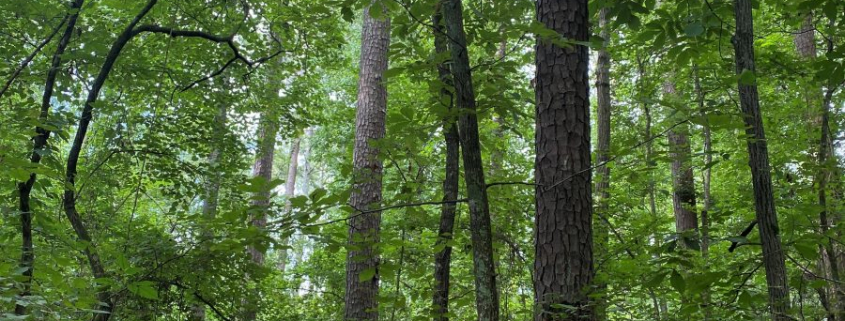August Riparian Forest Roaming at the Wheeler National Wildlife Refuge
August 1, 2020 I invested more than three hours bushwhacking (hiking off-trail) through the upland riparian forests along the Tennessee River on the east end of Wheeler National Wildlife Refuge. I admit that my hunger for golden chanterelles served as incentive to challenge mosquitoes, deer flies, horse flies, ticks, chiggers, briers, poison ivy, draped spider webs, and perhaps a venomous snake or two. I suffered no wounds, venom, or other insults. I harvested some seven pounds of golden chanterelles for my own consumption, a bounty worth every bit of sweat!
The Upland Riparian Forest
Allow me to introduce the forest. First the entrance sign, the road passing into an upland forest dominated by loblolly pine (Pinus taeda). The gravel parking area where I began my ramblings lies about a mile to the south, just a few hundred feet from where a flooded slough blocked the road for much of the winter and spring. No standing water now, even in depressions matted with leaves indicating wet season inundation.
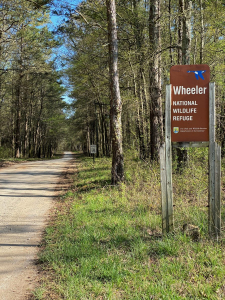
Moss-draped, buttressed white oak (Quercus alba) bases suggest deep shade and moist understory micro-climate. Rich alluvial soils support towering individuals, reaching more than 100 feet heavenward and spreading wide.
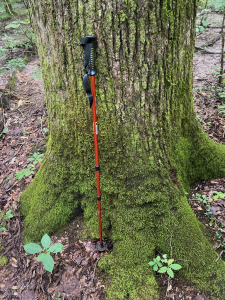
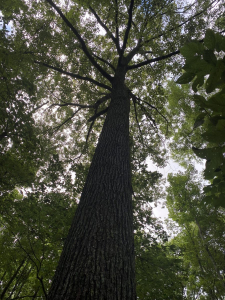
I felt small and insignificant among the giants in this maturing forest. Had I stayed on the Refuge’s gravel roads my respect, admiration, inspiration, and sense of humility would have been lessened by the perspective of looking into the forest instead of witnessing the grandeur from within the forest and wandering under the high canopy. Nothing beats the view directly vertical and the intimate physical contact with thick trunks.
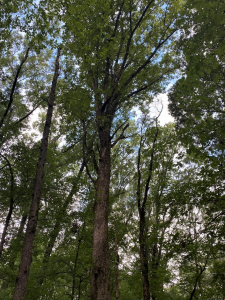
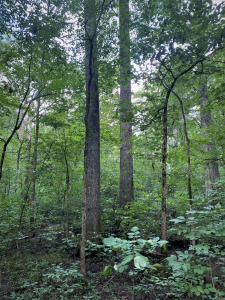
Perhaps some day I will own and operate a camera that better captures the depth of field intimated by the image below. There’s pure magic in the southern riparian forest. For those readers (western big tree effete snobs) who may peer down their noses at this old southern forester who sees the wonder in such eastern forests. Sure, I’ve stood jaw-dropped among the ancient redwoods, coastal Douglas firs, and giant sequoias. If I were to visit them again I would prescribe a period of recovery and recalibration upon returning to our eastern forests, readjusting my amazement scalar. Similarly, nearly two years passed after my four years living in Alaska before salmon here in the East once again earned my culinary respect and delight. The forest I visited is just a relative youngster compared to 1,000-year-old Douglas fir; 2,000-year-old redwood; 3,000-year-old sequoia! Eighty to 90 years ago, TVA crews cleared the forests growing in the areas to be flooded and on the buffer-lands acquired along what would be the lake shore. My Dad wasn’t yet a teenager when this natural hardwood forest regenerated. When my Dad was ten, The General Sherman sequoia looked much as it does today.
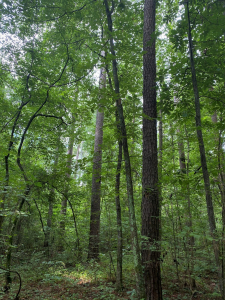
Watch for a near-future Post when I chronicle my wanderings through a similar riparian stand beginning to slip from a maturing stage of development into what I’ll refer to as old-growth, when age begins taking its toll, but I digress. The forked shagbark hickory (below left; Carya ovata) retains good health and vigor. Even the poison ivy (Toxicodendron radicans) clinging to the sweetgum (Liquidambar styraciflua) speaks vibrancy.
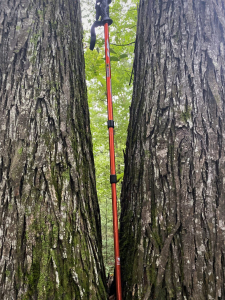
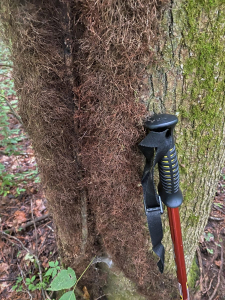
Not a main canopy resident, devil’s walking stick (Aralia spinosa) adds an element of curiosity to the understory. Aptly named, this species sprouts thorns that would slice the careless hand that dared employ it as a trekking pole! Only Satan can use it without self-harm.
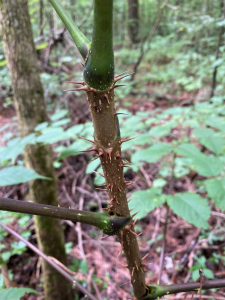
These forests are filled with magic and wonder, whether the magnificent main canopy residents or a humble devil’s walking stick surviving in the understory. But it’s not just the living and vibrant that drew my attention as I wandered off-trail.
Life (and Death) in the Forest
I repeat time and again that no forest is fixed in time. Our dynamic forest ecosystems represent a continuum, developing constantly across the seasons, years, and decades. This current stand originated 80-90 years ago, not from thin air, but as a result of a prior forest cut during the years of Wheeler dam construction, as the Corps of Engineers prepared the future lake bed and cleared buffer forests on adjacent lands purchased as part of the original property acquisition. The resultant naturally regenerated buffer zone forest is a work in progress, changing year in and year out. We’ll explore some elements of the ongoing life and death processes that define these wonderful forests along the Tennessee River (Wheeler Lake). The loblolly pine (below left) measured about ten inches in diameter when it succumbed sometime 5-10 years ago. It still retains an intact bark ring at ground level. The sapwood (Merriam-Webster online definition: the younger softer living or physiologically active outer portion of wood that lies between the cambium and the heartwood and is more permeable, less durable, and usually lighter in color than the heartwood) has fully decayed and disappeared in the damp and more favorable decay environment within a foot of the ground. The sapwood is rotted above that level, not yet fully consumed. The heartwood (Merriam-Webster online: the older harder nonliving central wood of trees that is usually darker, denser, less permeable, and more durable than the surrounding sapwood) appears decay-free and retains strength sufficient to keep the dead snag upright. I found nearby a rather ornate three-foot loblolly heartwood remnant (below right). The accompanying sapwood has long since returned to the soil. This section is resin-soaked, dense, hard, and decay resistant. I confess to bringing it home to serve as a landscape complement. It will last as long as I do, me being far less able to stave off the advance of time and aging!
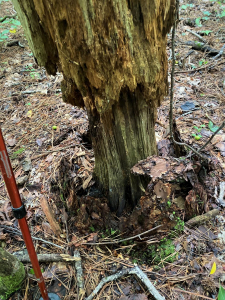
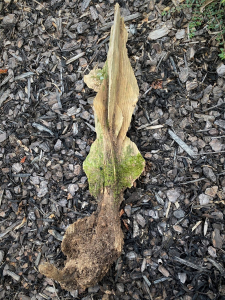
Saprophytic fungi are laboring (feeding voraciously) throughout the forest. This standing dead oak stem (about five-inches in diameter) will not remain vertical for more than another year or so. Again, nothing in Nature is static. The false turkey tail (Stereum ostrea) will continue its work after the stem is horizontal. Another Stereum (it may even be the same species) also sprouted fruiting bodies before it fell (below right). Note that some of the mushrooms on the left end are aligned vertically, evidencing that they predated the stem’s fall. Those aligned along the lower part of the photo emerged after the stem lay horizontal. Nature evidences her dynamism vividly to those who take time to see and care deeply enough to understand.
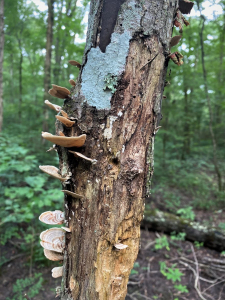
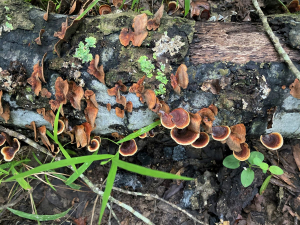
Much of the dead woody debris is already on the ground where many varieties of fungi are doing their recycling duty. A species of Trametes adorns the branch below left. I believe the lower right mushroom is another Trametes, perhaps species coccinea or cinnabarina, but I offer those possibilities with little confidence. Most of the Trametes live on dead wood, as do the two below.
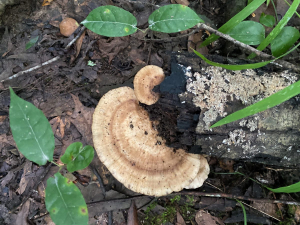
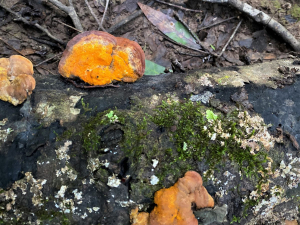
Honeycomb coral slime mold (Ceratiomyxa fruticulosa) decorates the fibers of the well-decayed log below. Gary Emberger, Messiah College, posted this excellent description: While not fungi, slime molds often form spore-bearing structures that resemble those of the true fungi. Although many slime mold species fruit on wood they do not form a penetrating and absorptive mass of hyphae in the wood
substrate. Rather, slime molds form structures called plasmodia which are naked (i.e., without cell walls) masses of protoplasm which can move and engulf particles of food in an amoeboid manner. Slime mold plasmodia creep about over the surfaces of materials, engulfing bacteria, spores of fungi and plants, protozoa, and particles of nonliving organic matter. At some point, plasmodia convert into spore-bearing structures. In Ceratiomyxa fruticulosa, the plasmodium converts into a clustered mass of stalks bearing spores on their surfaces. There is evidence that the spores are actually one-celled sporangia. So, I admit to assuming that this was a delicate coral fungus. It’s a strange new world for a forester who knows trees… and is trying to know more about all living elements of the forest ecosystem!
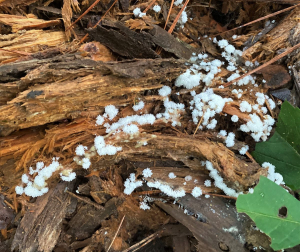
And if you thought the honeycomb coral slime mold an oddity, hang on for this one, wolf’s milk slime mold (Lycogala epidendrum). From midwestnaturalist.com: Found after rains on well-rotted logs throughout the Midwest (and the rest of North America), Lycogala epidendrum is probably our continent’s most frequently noticed slime mold. The fruiting bodies, called “aethalia,” are round and pink at first, but they become gray to brownish with age. They look very much like puffballs. But Lycogala epidendrum is not a mushroom; it just looks like one. Poke one of the fresh, pink lumps with a stick or knife, and you will quickly discover something very un-mushroom-like: it is filled with bright pink, sticky goo (presumably the “wolf’s milk” in the slime mold’s common name). However, as the slime mold grows older, the surface becomes purplish, then gray or brown. I’m learning more and more each time I write one of these Blog Posts!
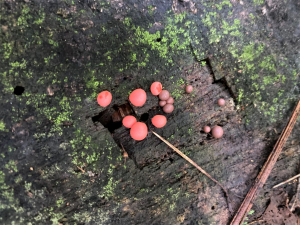
I loved the red-varnished surface of this polypore shelf fungus, which I believe is Ganoderma lucidum. I like to explore the internet for confirmation of my mushroom identification and to learn more about the level to which any species might be medicinal, edible, or fatal. Here’s what I found on Tom Wolf’s Fungus of the Month for March 2005 page: Ganoderma lucidum is important as a medicine in the Far East, in places such as China, Japan and Korea. G. lucidum is of particular interest because it has been portrayed as a “fix-it-all” herbal remedy for maladies such as: HIV, cancer, low blood pressure, high blood pressure, diabetes, rheumatism, heart problems, paralysis, ulcers, asthma, tiredness, hepatitis A, B, and C, insomnia, sterility, psoriasis, mumps, epilepsy, alcoholism, and the list goes on. These claims are mostly made by the people who are selling G. lucidum herbal supplements, but G. lucidum, also known as Reishi, ling chih, and ling zhi has a long history of being used as an herbal remedy. Wow, maybe I’ll just cancel my upcoming annual physical… or, perhaps not!
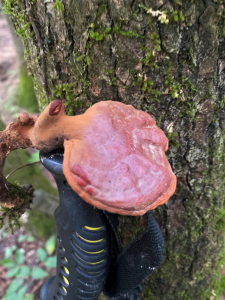
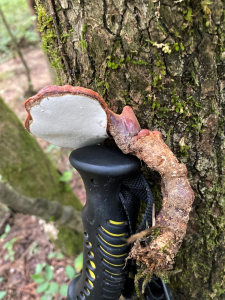
I routinely call this common yellow mushroom, ubiquitous in our summer forests dominated by oaks, yellow patches (Amanita flavoconia). As is so often the case, I have not confirmed the identity. Unforgivably, I take what I think will be photographs with detail sufficient to make a definitive identity, only to find that without the specimen in hand, I cannot. I need to explore a better field guide…I can’t take the internet into the woods in the many places I explore without adequate signal. So, for now, this beauty shall remain yellow patches.
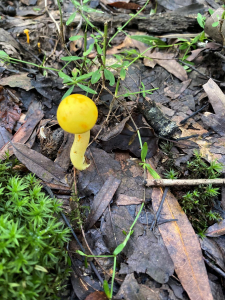
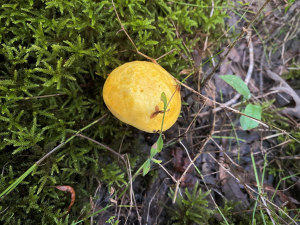
This white coral fungus (Ramariopsis kunzei) occurred throughout the riparian forest… as scattered individuals and occasionally in groupings of several. The mushroom guides I consulted online declared them edible, but not with enough enthusiasm to prompt me to collect a bagful next time. One source offered that the mushroom, while edible, is fleshless and flavorless. Other authors concur that the odor and taste are not distinctive. Fleshless and flavorless do not excite my culinary interests!
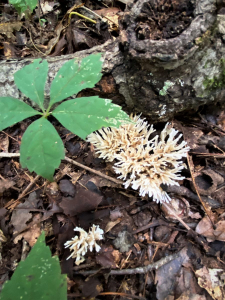
Heaven on Earth — from the Soil, the Essence of Earth
Now, here’s a golden jewel that does lead me to drool in anticipation. The WildEdible site declares that golden chanterelles (Catharellus cibarius) are probably the most well known wild mushrooms. They’re sought after by chefs and foodies due to their delicate flavor, which some describe as “mildly peppery.” Ranging in color from yellow to deep orange, golden chanterelles are easy to spot in the summer forest. They can be as big as 5 inches in diameter, but 2 inches is closer to average. The cap is wavy and generally funnel shaped. Their false gills appear as wrinkles that are forked and wavy with blunt edges and run down the stem, the same color as the rest of the chanterelle. Chanterelles also have a distinct fruity apricot-like aroma.
Here’s the news from the website that had my heart racing in anticipation: Chanterelles generally occur from late spring through late summer or early fall here in North Georgia. They love moisture, shade and lots of organic matter. Drenching rain followed by a couple of days of stifling heat is the natural sauna necessary to spawn a good bloom. Okay, bring on those drenching rains… the stifling heat is not going anywhere until mid-September!
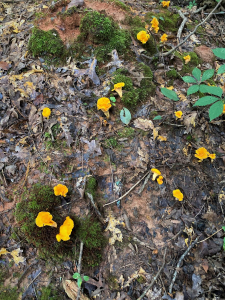
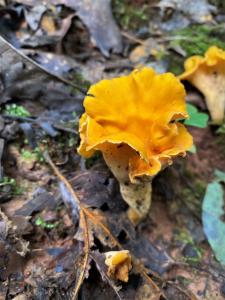
My new-found edible mushroom foraging has unleashed a literal hunger within. I want to learn more. I searched without success this past spring for morels. I am determined to find the right places next spring. I found oyster mushrooms last fall and summer oysters since then. And recently I discovered black-staining polypore. And toss in the incredible lions main! All of these are culinary delights! Now I’m beginning to look for chicken of the woods. I am approaching a level of near-obsessive. Who could not be excited by the display below, ready for sauteing?
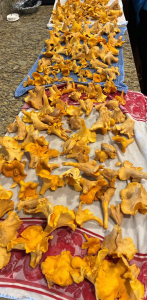
The local forest ecosystem offers rewards of wonder, inspiration, nutrition, and culinary delight. We are continuing to deal with Covid-19… five months after China released it Earth-wide. Yet, I have yet to don a mask when wandering through the woods. I am grateful beyond words that I live in a place rich with Nature… and not place-bound in some densely populated urban zone.
Thoughts and Reflections
I offer three observations from my early August trek through the woods:
- There’s pure magic in the southern riparian forest.
- Nature evidences her dynamism vividly to those who take time to see and care deeply enough to understand.
- I am grateful beyond words that I live in a place rich with Nature.
-
Inhale and absorb Nature’s elixir. May Nature Inspire, Inform, and Reward you!
Note: All blog post images created & photographed by Stephen B. Jones unless otherwise noted. Please circulate images with photo credit: “©2020 Steve Jones, Great Blue Heron LLC. All Rights Reserved.”
Another Note: If you came to this post via a Facebook posting or by an another route, please sign up now (no cost… no obligation) to receive my Blog Post email alerts: http://eepurl.com/cKLJdL
And a Third: I am available for Nature-Inspired Speaking, Writing, and Consulting — contact me at steve.jones.0524@gmail.com
Reminder of my Personal and Professional Purpose, Passion, and Cause
If only more of us viewed our precious environment through the filters I employ. If only my mission and vision could be multiplied untold orders of magnitude:
Mission: Employ writing and speaking to educate, inspire, and enable readers and listeners to understand, appreciate, and enjoy Nature… and accept and practice Earth Stewardship.
Vision:
- People of all ages will pay greater attention to and engage more regularly with Nature… and will accept and practice informed and responsible Earth Stewardship.
- They will see their relationship to our natural world with new eyes… and will understand more clearly their Earth home.
Tagline/Motto: Steve (Great Blue Heron) encourages and seeks a better tomorrow through Nature-Inspired Living!
Steve’s Three Books
I wrote my books Nature Based Leadership (2016), Nature-Inspired Learning and Leading (2017), and Weaned Seals and Snowy Summits: Stories of Passion for Place and Everyday Nature (2019; co-authored with Dr. Jennifer Wilhoit) to encourage all citizens to recognize and appreciate that every lesson for living, learning, serving, and leading is either written indelibly in or is powerfully inspired by Nature.
I began writing books and Posts for several reasons:
- I love hiking and exploring in Nature
- I see images I want to (and do) capture with my trusty iPhone camera
- I enjoy explaining those images — an educator at heart
- I don’t play golf!
- I actually do love writing — it’s the hobby I never needed when my career consumed me
- Judy suggested my writing is in large measure my legacy to our two kids, our five grand kids, and all the unborn generations beyond
- And finally, perhaps my books and Blogs could reach beyond family and touch a few other lives… sow some seeds for the future


All three of my books (Nature Based Leadership; Nature-Inspired Learning and Leading; Weaned Seals and Snowy Summits) present compilations of personal experiences expressing my (and co-author Dr. Wilhoit for Weaned Seals and Snowy Summits) deep passion for Nature. All three books offer observations and reflections on my relationship to the natural world… and the broader implications for society. Order any and all from your local indie bookstore, or find them on IndieBound or other online sources such as Amazon and LifeRich.

